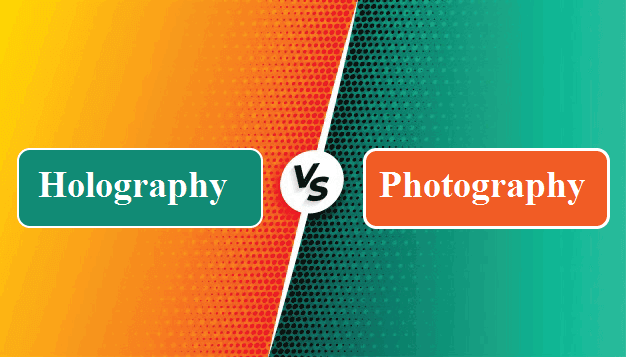Difference between Holography and PhotographyHolography and Photography both terms look similar, but they are different from one another. The primary distinction between these techniques is that holography focuses on creating three-dimensional images. In contrast, photography often produces two-dimensional photos of three-dimensional objects. Although, the techniques used to create the images differ, with holography employing light interference between the light reflected from the object and the reference beam. In contrast, photography employs photographic film onto which light is happening after reflecting from an object. In this article, you will learn about the difference between Holography and Photography. But before discussing the differences, you must know about Holography and Photography with their advantages and disadvantages. What is Holography?Holography is a technique for recording and later reconstructing a wavefront. It is most recognized for its ability to produce true 3D images, but it has a large range of other applications. It is a technique for generating elaborate, hyper-realistic realities. These are exact and indelible tracings of the real thing or occasionally complex fakes. Holography was originally introduced by Dennis Gabor in 1947. Dennis Gabor was later awarded the Nobel Prize in 1971 for discovering the 3D lensless technique of photography (i.e., holography). Holography utilizes an interferometric approach that records the light wave's phase and amplitude. The recorded image is completely 3D, which implies that each different perspective of the image may be visualized by considering the recorded image from various angles. Holography consists of two steps: the first is to record a holographic "photo" using light wave interference, and the second is to reconstruct the object from the hologram using light wave diffraction. Many applications of holography include industrial nondestructive testing, ultrasonic holography, holographic microscopy, holographic memory, holographic film and television. How does Holography Work?It is explained in mainly two steps:
Recording of the hologram A plane mirror divides the laser beam into two parts. One portion of the laser beam shows the object on which the hologram will be created. The other portion of the laser beam, known as the reference Beam or wave which is acquired on the photographic plate after reflection from the plane mirror. As a result, the photographic plate is exposed to both the beam and the light beam reflected from the object at the same time. These two light waves or beams are in sync. The superposition of utilized beams of light produces an interference pattern on the holographic plate. The hologram is created when the photographic plate or film is produced. The amplitude and object wave's phases are both represented in the hologram. Reconstructing the image The technique of reproducing a 3-Dimensional image of an object is known as reconstruction. The hologram is illuminated once again by a single laser beam known as the reconstruction wave to see an object's image. This reconstruction wave is the same as the reference wave utilized to capture the hologram. The graphic shows the formation of the object's real and virtual pictures. When an observer moves his eyes from one side to another, the near part of the object seems to move to the far section of the object. As a result, the viewer notices the depth of the image and the 3-dimensional effect of the image. Advantages and Disadvantages of HolographyThere are various advantages and disadvantages of Holography. Some main advantages and disadvantages of holography are as follows: Advantages
Disadvantages
What is Photography?Photography is a method of generating two-dimensional images of three-dimensional objects. It uses a lens system to concentrate the image or object on the photographic plate, with just one plane focused at a time and the rest planes out of focus. Joseph Nicéphore Niépce took the first permanent photograph in France in 1826. A photograph records the dispersion of light intensity at the plane. The light-sensitive medium detects only fluctuating intensities, and therefore the phase distribution acquired at the photograph's plane is lost. As a result, while viewing a photograph from various perspectives, the image's perspective cannot be changed. Additionally, it is not possible to refocus the out-of-focus areas of a shot. Features of the PhotographyThere are various features of photography. Some main features of the photography are as follows:
Key differences between Holography and Photography
There are various key differences between Holography and Photography. Some of the key differences between Holography and Photography are as follows:
Head-to-head comparison between Holography and PhotographyHere, you will learn the head-to-head comparisons between Holography and Photography. The main differences between Holography and Photography are as follows:
ConclusionHolography and photography are two distinct methods for producing 3D and 2D images, respectively, and both are equally important. Holography produces photos that appear three-dimensional. In contrast, photography produces two-dimensional photographs.
Next TopicDifference between
|
 For Videos Join Our Youtube Channel: Join Now
For Videos Join Our Youtube Channel: Join Now
Feedback
- Send your Feedback to [email protected]
Help Others, Please Share










